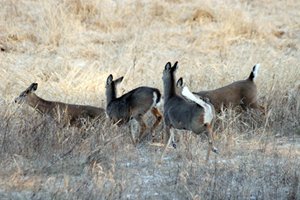
On a recent turkey hunting morning, I watched 10 antlerless deer prance by about 150 yards out from my hidey hole in a brushrow, during a 45-minute span.
First, six of them passed in a band, then two, and singles twice. All of them followed the same track – as if them were actually on tracks – about 25 yards outside a woods-line. Watching the deer in binoculars – the gobblers were silent and invisible anyway – I could see that the flanks on at least half of them were swollen with fawns, to be birthed in the next months or so.
On another morning soon afterward, my buddy and I were driving the backroads to our turkey stands and we watched nine deer pop up out of a narrow strip roadside grass, where they must have been bedded for some time. Pop-pop-pop, up they came one after another in the headlights of the truck.
I make the foregoing observations to illustrate a point we may not often consider: Deer are very active in springtime in the pre-fawning period.
Most outdoors folk understand that deer can be a highway collision threat in the fall, when the rut, the agricultural crop harvest, and to a lesser degree hunters keep them on the move much more than usual. But sometimes we do not remember the spurt of activity in the spring.
“As white-tailed does are preparing to give birth to fawns, their year-old offspring are scattering to find their own territories, sometimes entering areas they wouldn’t normally,” said Scott Peters, wildlife management supervisor for Division of Wildlife. “At night, dispersing deer may wander across roadways and into highly populated areas of the cities and suburbs. As dawn arrives young deer often find themselves in unfamiliar surroundings and then try to find their way back out of town,” Peters added. Early morning traffic is often heavy where these deer may cross, so commuters should be alert.
So, stay on top of your driving game and watch for the game, especially at peak deer-movement hours around dawn and dusk. And remember, where there is one, there may be more. Mind the “deer crossing” signs as well; they were placed at a given site because deer are known to cross frequently.
Last and not least, try to fight the urge to swerve to avoid a collision. In some cases, swerving can cause a worse accident and endanger other motorists. Maintaining full control of your vehicle is the most important factor for your safety, highway safety authorities note.

